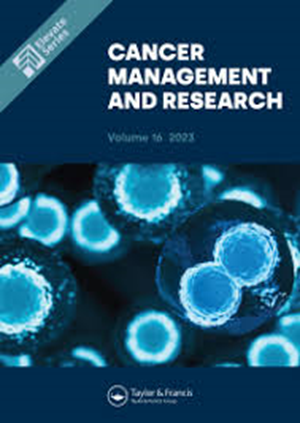Machine Learning for Prediction of Non-Small Cell Lung Cancer Based on Inflammatory and Nutritional Indicators in Adults: A Cross-Sectional Study
IF 2.5
4区 医学
Q3 ONCOLOGY
引用次数: 0
Abstract
Purpose: The aim of this study was to evaluate the potential benefit of blood inflammation in the diagnosis of non-small cell lung cancer (NSCLC) and propose a machine-learning-based method to predict NSCLC in asymptomatic adults.Patients and Methods: A cross-sectional study was evaluated using medical records of 139 patients with non-small cell lung cancer and physical examination data from May 2022 to May 2023 of 198 healthy controls. The NSCLC cohort comprised 128 cases of adenocarcinoma, 3 cases of squamous cell carcinoma, and 8 cases of other NSCLC subtypes. The correlation between inflammatory and nutritional markers, such as monocytes, neutrophils, LMR, NLR, PLR, PHR and non-small cell lung cancer was examined. Features were selected using Python’s feature selection library and analyzed by five algorithms. The predictive ability of the model for non-small cell lung cancer diagnosis was assessed by precision, accuracy, recall, F1 score, and area under the curve (AUC).
Results: The results showed that the top 14 important factors were PDW, age, TP, RBC, HGB, LYM, LYM%, RDW, PLR, LMR, PHR, MONO, MONO%, gender. Additionally, the naive Bayes (NB) algorithm demonstrated the highest overall performance in predicting adult NSCLC among the five machine learning algorithms, achieving an accuracy of 0.87, a macro average F1 score of 0.85, a weighted average F1 score of 0.87, and an AUC of 0.84.
Conclusion: In feature ranking, platelet distribution width was the most important feature, and the NB algorithm performed best in predicting adult NSCLC diagnosis.
Keywords: machine learning, non-small cell lung cancer, inflammatory indicators, nutritional indicators, ratio, diagnosis
基于炎症和营养指标的成人非小细胞肺癌预测机器学习:一项横断面研究
目的:本研究旨在评估血液炎症对诊断非小细胞肺癌(NSCLC)的潜在益处,并提出一种基于机器学习的方法来预测无症状成年人的NSCLC:利用139名非小细胞肺癌患者的医疗记录和198名健康对照者2022年5月至2023年5月的体检数据,对一项横断面研究进行了评估。非小细胞肺癌队列包括128例腺癌、3例鳞状细胞癌和8例其他非小细胞肺癌亚型。研究人员检测了单核细胞、中性粒细胞、LMR、NLR、PLR、PHR 等炎症和营养标记物与非小细胞肺癌之间的相关性。使用 Python 的特征选择库选择特征,并通过五种算法进行分析。模型对非小细胞肺癌诊断的预测能力通过精确度、准确度、召回率、F1得分和曲线下面积(AUC)进行评估:结果显示,排在前14位的重要因素分别是PDW、年龄、TP、RBC、HGB、LYM、LYM%、RDW、PLR、LMR、PHR、MONO、MONO%、性别。此外,在五种机器学习算法中,天真贝叶斯(NB)算法在预测成人 NSCLC 方面的总体性能最高,准确率达到 0.87,宏观平均 F1 得分为 0.85,加权平均 F1 得分为 0.87,AUC 为 0.84:关键词:机器学习;非小细胞肺癌;炎症指标;营养指标;比值;诊断
本文章由计算机程序翻译,如有差异,请以英文原文为准。
求助全文
约1分钟内获得全文
求助全文
来源期刊

Cancer Management and Research
Medicine-Oncology
CiteScore
7.40
自引率
0.00%
发文量
448
审稿时长
16 weeks
期刊介绍:
Cancer Management and Research is an international, peer reviewed, open access journal focusing on cancer research and the optimal use of preventative and integrated treatment interventions to achieve improved outcomes, enhanced survival, and quality of life for cancer patients. Specific topics covered in the journal include:
◦Epidemiology, detection and screening
◦Cellular research and biomarkers
◦Identification of biotargets and agents with novel mechanisms of action
◦Optimal clinical use of existing anticancer agents, including combination therapies
◦Radiation and surgery
◦Palliative care
◦Patient adherence, quality of life, satisfaction
The journal welcomes submitted papers covering original research, basic science, clinical & epidemiological studies, reviews & evaluations, guidelines, expert opinion and commentary, and case series that shed novel insights on a disease or disease subtype.
 求助内容:
求助内容: 应助结果提醒方式:
应助结果提醒方式:


